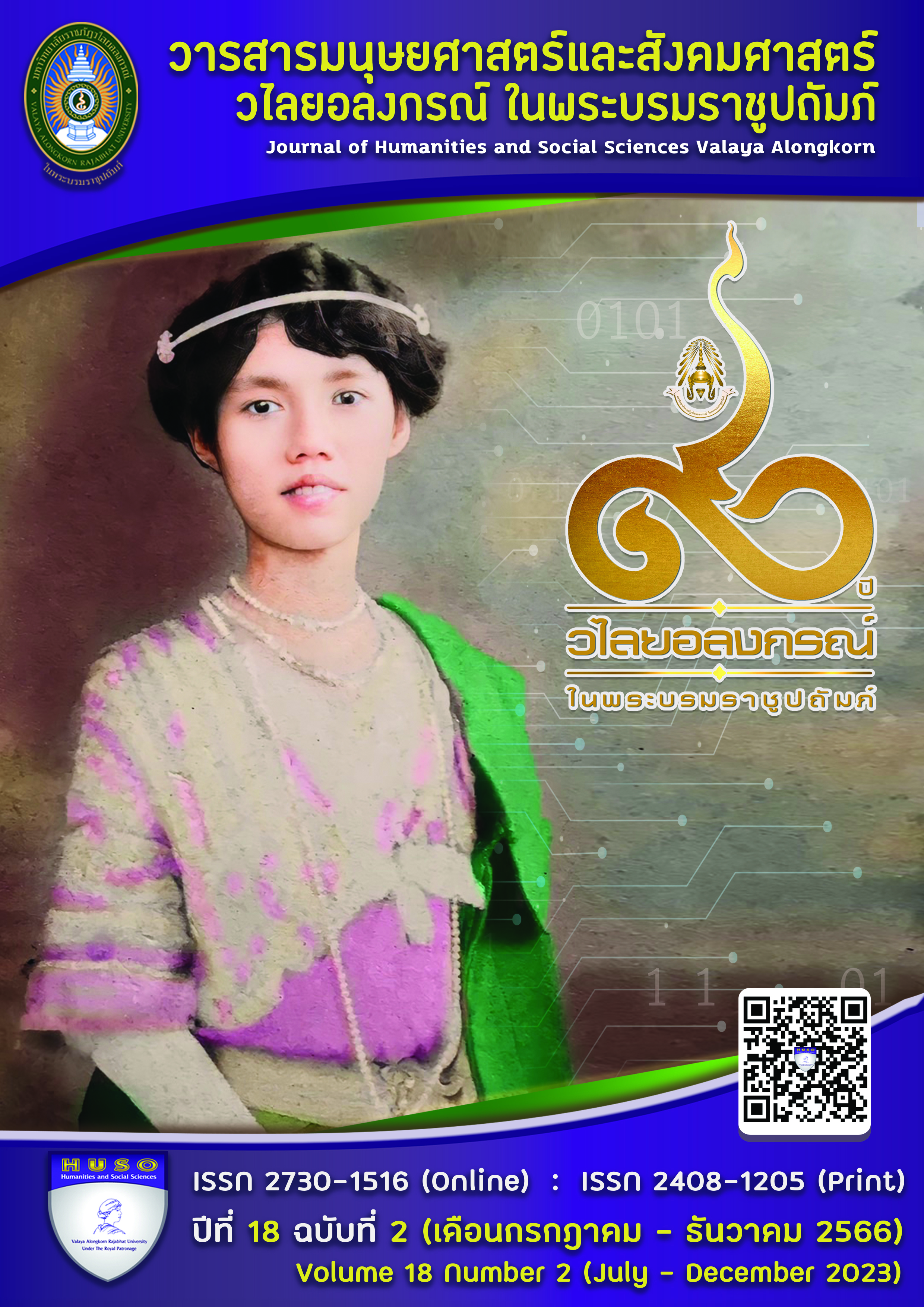RELATIONSHIP BETWEEN SOCIAL SUPPORT, DEATH ATTITUDE, AND DEATH PREPARATION BEHAVIOR AMONG KASETSART UNIVERSITY STUDENTS
Main Article Content
Abstract
The objectives of this mixed methods study were to investigate: (1) the level of social support, attitudes towards death, and death preparation behavior; (2) the relationship between social support, death attitude, and death preparation behavior; and (3) viewpoints of social support, death attitude and death preparation behavior among Kasetsart University students. The study sample comprised 140 undergraduate students at Kasetsart University Bangkhen Campus, Academic Year 2022. Of these, 120 participants were recruited by quota sampling for quantitative study, and data were collected using questionnaires. The quantitative data were analyzed using frequency, percentage, mean, standard deviation, and Pearson's product-moment correlation coefficient. Next, 20 volunteer participants were selected by purposive sampling for in-depth interviews. The qualitative data collected were analyzed using content analysis. The results indicate a high level of students’ social support (M= 3.68, SD=0.55), and moderate levels of attitude toward death and death preparation behavior (M= 3.17, SD=0.73 and M=2.83, SD=0.52, respectively). Moreover, death attitude had a moderate positive correlation with death preparation behavior (r=.53, p<.05), while there was no relationship between social support and death preparation behavior, nor between social support and death attitude. Furthermore, the in-depth interview on social support revealed that social support helps students to improve their death preparation behavior, and the most important sources of social support are family and friends. Students hold different ideas about life after death and contemplation of death, but most students perceive death as a natural thing that happens in life. Most participants have a positive perception toward death preparation behavior and believe that if they were prepared for death, they would live a happier life. However, most of them have not yet engaged in death preparation.
Article Details

This work is licensed under a Creative Commons Attribution-NonCommercial-NoDerivatives 4.0 International License.
ลิขสิทธิ์บทความวิจัยที่ได้รับการตีพิมพ์เผยแพร่ในวารสารมนุษยศาสตร์และสังคมศาสตร์ วไลยอลงกรณ์ ในพระบรมราชูปถัมภ์ ถือเป็นกรรมสิทธิ์ของคณะมนุษยศาสตร์และสังคมศาสตร์ มหาวิทยาลัยราชภัฏวไลยอลงกรณ์ ในพระบรมราชูปถัมภ์ ห้ามนำข้อความทั้งหมดหรือบางส่วนไปพิมพ์ซ้ำ เว้นแต่จะได้รับอนุญาตจากมหาวิทยาลัยเป็นลายลักษณ์อักษร
ความรับผิดชอบ เนื้อหาต้นฉบับที่ปรากฏในวารสารมนุษยศาสตร์และสังคมศาสตร์ วไลยอลงกรณ์ ในพระบรมราชูปถัมภ์ เป็นความรับผิดชอบของผู้นิพนธ์บทความหรือผู้เขียนเอง ทั้งนี้ไม่รวมความผิดพลาดอันเกิดจากเทคนิคการพิมพ์
References
กรรณจริยา สุขรุ่ง. (2551). สุขสุดท้ายที่ปลายทาง เผชิญความตายอย่างสงบ (พิมพ์ครั้งที่ 3). กรุงเทพมหานคร:ห้างหุ้นส่วนสามลดา.
จิวีณา พีชะพัฒน์, ณาตรการณ์ ชยุตสาหกิจ และณิชา ศิลปวัฒนานันท์. (2554). ผลของการรับรู้ ความสามารถของตนเองและการรับรู้การสนับสนุนทางสังคมต่อสุขภาวะในวัยรุ่นตอนต้น [วิทยานิพนธ์ศิลปศาสตรมหาบัณฑิต]. จุฬาลงกรณ์มหาวิทยาลัย. http://cuir.car.chula.ac.th/handle/123456789/47862
พระชาย อภินนฺโท. (2561). ปัจจัยที่มีความสัมพันธ์กับพฤติกรรมการเตรียมตัวก่อนตายของผู้สูงอายุ
ในชมรมปฏิบัติธรรม ๒๔ น. จังหวัดปราจีนบุรี [วิทยานิพนธ์ศิลปศาสตรมหาบัณฑิต]. มหาวิทยาลัยมหาจุฬาลงกรณ์ราชวิทยาลัย. http://lp.mcu.ac.th/userfiles/file/วิทยานิพนธ์/ปริญญาโท/พุทธจิตวิทยา2562/62MCU620 22002.pdf
ไพศาล แย้มวงษ์. (2555). การศึกษาการสนับสนุนทางสังคมที่ส่งผลต่อความพึงพอใจในชีวิตของนักศึกษามหาวิทยาลัยธรรมศาสตร์ [วิทยานิพนธ์ศิลปศาสตรมหาบัณฑิต]. มหาวิทบาลัยศรีนครินทรวิโรฒhttps://ir.swu.ac.th/jspui/handle/123456789/3622
มหาวิทยาลัยเกษตรศาตร์. (2566, 20 มกราคม). จำนวนนิสิตปัจจุบัน มหาวิทยาลัยเกษตรศาตร์. https://regis.ku.ac.th/cpcmns/rpt_std_ku3.php
มารยาท สุจริตวรกุล และสิริลักษณ์ โสมานุสรณ์. (2561). ปัจจัยที่มีความสัมพันธ์กับการเตรียมตัวเพื่อการตายของผู้สูงอายุไทยพุทธ. วารสารเกื้อการุณย์, 25(1), 154-169.
มิตซูโอะ คเวสโก. (2552). ใจดีสู้เสือ. มูลนิธิมายาโคตมี.
รัตนาภรณ์ มั่นศรีจันทร์. (2559). ทัศนคติของประชาชนจังหวัดเพชรบุรีที่มีต่อการบริหารงาน ขององค์การบริหารส่วนจังหวัดเพชรบุรี : ศึกษาในห้วงเวลา ปี 2559 [วิทยานิพนธ์รัฐประศาสนศาสตรมหาบัณฑิต]. มหาวิทยาลัยเกริก. https://mis.krirk.ac.th/librarytext/ PCC/2559/F_Rattanaporn _Munsrijan.pdf
วรรณภา คุณากรวงศ์. (2562, 11 เมษายน). เตรียมตัวก่อนวาระสุดท้าย เลือกอยู่หรือไปให้ได้อย่างหวัง.https://tdri.or.th/2019/04/attitude-toward-palliative-care-in-thailand/
สารภี รังษีโกศัย. (2556). ปัจจัยที่มีความสัมพันธ์กับพฤติกรรมการเตรียมตัวเพื่อเผชิญกับความตาย
และภาวะใกล้ตาย ของผู้สูงอายุในชมรมผู้สูงอายุจังหวัดปัตตานี [วิทยานิพนธ์วิทยาศาสตรมหาบัณฑิต]. มหาวิทยาลัยบูรพา. http://digital_ collect.lib.buu.ac.th/dcms/files/51910148.pdf
เอกพล สมการ และมานิตย์ อรรคชาต. (2562). ทัศนคติต่อความตายของนักศึกษาระดับปริญญาตรี
คณะครุศาสตร์ มหาวิทยาลัยราชภัฏนครราชสีมา. วารสารมนุษยศาสตร์, 11(2), 33-46.
Barnett, J., Thorpe, S., & Young, T. (2018). Characterising and justifying sample size sufficiency in interview-based studies: Systematic analysis of qualitative health research over a 15-year period. BMC Medical Research Methodology, 18(148), 1-18. https://doi.org/10.1186/s12874---018-0594-7.
Cobb, S. (1976). Social support as a moderator of life stress. Psychosomatic Medicine, 38(5),
-314.
Dalton, J. H., Elias, M.J., Hill, J., Kloos, B., Thomas, E. & Wandersman, A. (2012). Community psychology: Linking individuals and communities (3rd ed.). Wadsworth Cengage Learning.
Danielsen, A. G., Samdal, O., Hetland, J., & Wold, B. (2009). School-related social support and students' perceived life satisfaction. The Journal of Educational Research, 102(4), 303–318. https://doi.org/10.3200/JOER.102.4.303-320
Han, H.-F., Hsieh, C.-J., Lin, P.-F., Chao, C.-H., & Li, C.-Y. (2022). Relationships of social support and attitudes towards death: A mediator role of depression in older patients on haemodialysis. Nursing Open, 9, 986–995. https://doi.org/10.1002/nop2.1135
Hinkle, D. E., Wiersma W., & Jurs, S. G. (2003). Applied statistics for the behavioral sciences (5 ed.). https://www.worldcat.org/title/Applied-statistics-for-the-behavioral-sciences/oclc/643936092.
Mai, Y., Wu, Y.J. and Huang, Y. (2021). What type of social support is important for student resilience during COVID-19? A latent profile analysis. Front Psychol, 12, 1-11. https://doi. org/10.3389/fpsyg.2021.646145
Peggy, A. T. (2011). Mechanisms linking social ties and support to physical and mental health.
Journal of Health and Social Behavior, 52(2). https://doi.org/10.1177/0022146510395592
Pender, N. (1996). Health promotion in nursing practice. Appleton and Lange.
Robert, A. N., Richard, P. M. and Joachim, W. (2016). Assessing attitudes toward dying and death:
Psychometric considerations. OMEGA - Journal of Death and Dying, 47(1).
https://doi.org/10.2190/EP4R-TULM-W52G-L3EX
Steinhauser, K. E., Christakis, N. A., Clipp, E. C., McNeilly, M., Grambow, S., Parker, J., & Tulsky, J. A. (2001). Preparing for the end of life: preferences of patients, families, physicians, and other care providers. Journal of pain and symptom management, 22(3), 727–737. https://doi.org/10.1016/s0885-3924(01)00334-7
Wong, P. T. P., Reker, G. T., & Gesser, G. (1994). Death attitude profile—revised:
A multidimensional measure of attitudes toward death. In R. A. Neimeyer (Ed.),
Death anxiety handbook: Research, instrumentation, and application (pp. 121–148).
Taylor & Francis.


